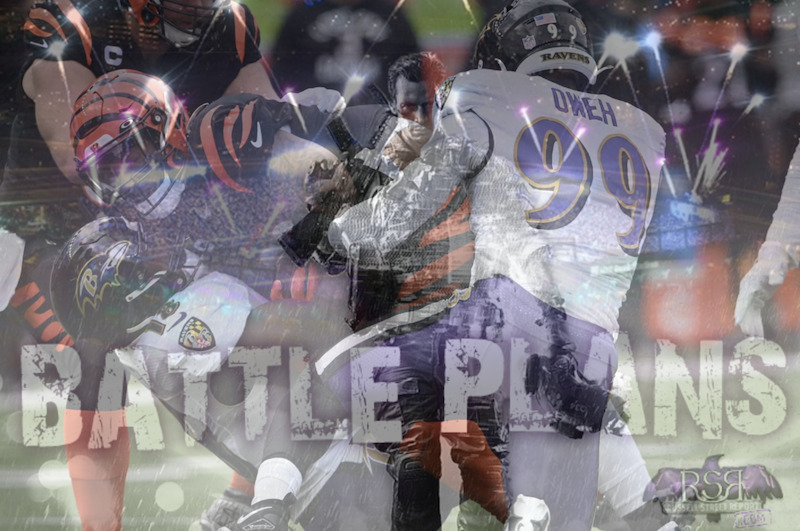RSR’s Dev Panchwagh and Nikhil Mehta are teaming up to bring you BATTLE PLANS in 2023.
Defense
Create Pass Rush Mismatch Opportunities
We’ve all seen the clip of Myles Garrett simulating crossover moves against the Bengals before the snap, prepared to attack the center from a stand-up position. Myles Garrett from a stand up rush? A diabolical move by defensive coordinator Jim Schwartz.
The Browns demolished the Cincinnati pass protection using this type of approach – namely moving their ends from traditional three-point stances to rush from more unconventional positions all along the line. Schwartz put his top talent in positions to win, exploiting the interior linemen, in particular putting left guard Cordell Volson in a blender.
Baltimore has the personnel to take a similar approach. Odafe Oweh and Jadaveon Clowney are equally versatile, able to rush from outside to inside, take on interior linemen, and alternate between hands-down and stand-up positions. In fact, Oweh rushed several times from an inside stunt/loop against the Texans, while Clowney was involved in line games to free up rushers.
Mike Macdonald should use the versatility of Oweh and Clowney to target the left side of the Bengals’ line. That’s going to draw help, either via Bengals C Ted Karras or a tight end. Either way, the Bengals protecting the left side of the line will open up opportunities for David Ojabo on the right, where he can give Jonah Williams fits on an island.
Look for Macdonald to take a page from Cleveland’s book and dial up different pass-rushing looks to give his rushers the chance to eat.
Five-Man Pressures
One way to do the above is through simulated pressure. Simulated pressure involves bluffing the blitz, showing defenders coming from a certain position before the snap, only to have them fake and typically drop. The point of this bait and switch is to create the illusion of the blitz. Force the offensive line and quarterback to think there are more defenders coming, slide the protection the wrong way, and ultimately create a numbers edge without sacrificing coverage integrity.
Macdonald has featured the sim pressure prominently, especially against the Bengals. The beauty of this pressure tactic is you can generate heat without necessarily having to rush more than five defenders, which is when you get into traditional blitz territory. It’s a great way to turn one of the Bengals’ greatest strengths – Joe Burrow’s pre-snap processing – against them. Burrow is great at a fundamental principle of quarterback play against the blitz: replacing the blitzer. That’s a lot harder to do when he doesn’t know who the blitzer is.
Against the Bengals and their stable of wide receivers – arguably the best trio in the league – rushing five through sim pressure is the most optimal approach. Baltimore’s secondary is depleted (a good chance CB Marlon Humphrey is out along with FS Marcus Williams). They can’t afford to expose the back end too often by sending Cover 0 blitzes.
Ideally, they won’t need to. Each member of Cincinnati’s starting OL surrendered at least two pressures vs. the Browns, per PFF. That means there’s opportunity on every dropback, whether it’s a straight four-man rush or a five-man simulated pressure. Consistent pressure will keep Burrow from getting comfortable and setting up explosive pass plays. Instead, he’ll have to dink-and-dunk his way down the field.
Back Alley Street Brawl
What stood out from last Sunday was just how physical the Baltimore defense played all around. But what really stood out was how aggressively the defensive backs played. Whether it was Brandon Stephens or newcomer Ronald Darby, the corners were hitting. Slot CB Ar’Darius Washington, a former safety, seems like a natural in the nickel, and he mixed it up too. Washington has added an infectious energy with his physical style.
They’ll all need to bring that same disposition to the Bengals’ playmakers on Sunday. Frankly, they already have been playing that way since last season. This defense isn’t afraid to get after the Cincinnati offense.
It’ll be critical for the secondary to keep the receivers in front and tackle with sound technique. They need to keep the yards after catch (YAC) to a minimum, along with the big plays, and rally to the ball.
With a fully-healthy secondary, Mike Macdonald would be throwing out all sorts of exotic disguised coverages and post-snap rotations to slow Burrow’s processing and make him second-guess his reads. You’ll see some of that on Sunday, but the onus of misdirection and deception will fall more on the pass-rush and how they attack the Bengals’ porous OL. The Ravens secondary just has to take care of business on the back end by limiting explosive plays and giving their formidable front seven the opportunity to make game-changing impacts.
Offense
Protecting Lamar
The Ravens’ offensive line struggled in the first half on Sunday before settling down in the second. That would have been an encouraging sign, if not for the injuries to Ronnie Stanley and Tyler Linderbaum, Baltimore’s two most important linemen. They have solid depth – it looks like Patrick Mekari and Sam Mustipher will start at LT and C, respectively – but that alone won’t be enough against a solid Bengals front.
One obvious solution is the continued deployment of Patrick Ricard as essentially a sixth offensive lineman from an inline TE alignment. Todd Monken used that plenty last week even before the injuries, so expect to see it again vs. Cincy. However, the Bengals don’t blitz very often, so they’ll have the numbers advantage in coverage when Ricard stays in to block.
As a result, Monken will have to get a bit more creative to avoid being too predictable and throttling the offense. Having Mark Andrews back would be huge to run multiple TE sets with Isaiah Likely. They can chip Sam Hubbard and Trey Hendrickson off the line of scrimmage and still threaten the defense as pass catchers.
Likely can also help out his quarterback by being a reliable check down option. Jackson has a spotty history of finding and hitting his check downs, and that’s partially because sometimes, he doesn’t have one other than his legs. That feeds directly into one of Jackson’s bad habits – holding onto the ball to try to force plays. But for him to get rid of the ball in the pocket, he has to have somewhere to go with it. Keeping Likely in to block before releasing as a check down provides Jackson with more time off the snap and a reliable outlet when he’s under pressure.
Monken also used both Rashod Bateman and Nelson Agholor to chip the Texans’ edge rushers last week, a creative way to slow down the pass rush. Expect to see that again this week, as well as more use of Zay Flowers as the motion man to freeze the defense.
Control the Tempo
Monken giving Jackson the keys to the offense was an oft-repeated storyline of training camp. To continue the metaphor, Jackson will have to adopt some principles of defensive driving now that his car is banged up. Without his parking sensors (his cerebral, reliable center) or blind spot detector (his All-Pro blindside protector), Jackson has to anticipate threats and take fewer risks.
Even though his offensive mindset is to step on the gas, Jackson is going to have to take his foot off the gas pedal to make sure his offense is set. The Ravens ran a lot of quick count vs. Houston, but that won’t be as effective against an experienced Cincy DL. In fact, moving too quickly could even play into Bengals DC Lou Anarumo’s gameplan to change looks post-snap. Jackson could think he sees one coverage coming up to the line, only for the defense to shift into something else entirely post-snap.
To counter that, he has to take his time to diagnose the disguised coverages that Anarumo will dial up. The Bengals will also run simulated pressures by overloading one side of the line and dropping either Hendrickson or Hubbard into coverage. Slowing down at the line of scrimmage can get defenders to tip their hands as they try to time to snap. Jackson can then make the necessary adjustments and, crucially, communicate them to his teammates. With a new OL combination – and multiple miscommunications with his RBs last week (Justice Hill ran into him, causing a fumble; Gus Edwards and LJ weren’t on the same page at all on another busted play) – Jackson has to make sure everyone is on the same page.
Precise and Decisive
Andrews’ potential return is great for Jackson and this offense but the Bengals know that, too. They’ll be keying on the All-Pro TE as the Ravens’ primary middle-of-field threat. Anarumo might show a two-high look pre-snap to bait a throw up the seam before having one of his safeties buzz into the middle post-snap.
But changing looks post-snap requires the defense to cover ground to hit their secondary landmarks, so there will be time and space to exploit. Jackson has the arm strength and quick release to make the throws, and we know Andrews can make the catches. But Jackson has to be decisive – no double-clutching like he did on his interception on Sunday. It gives away his intentions to the defense and takes velocity off his throw – the bread-and-butter of easy picks.
The Ravens can also be precise about where they are attacking. Post-snap rotations open up opportunities on the edges of the field where the offense can attack open space or favorable one-on-one matchups before additional help can arrive.
For example, WR screens are one way to do that. And they take the pressure off the OL. Monken called quite a few screens last week so the Bengals will be ready for them. The Ravens don’t have to avoid them entirely, but they should have a few wrinkles dialed up.
For example, they could fake a screen to Flowers with Beckham selling a block before releasing up the sidelines. Taking shots like that into the honey hole – 10-15 yards up the sideline behind a squatting cornerback – will be crucial to exploiting the Bengals’ disguised coverages. Flowers’ slot fade is a great example of how the Ravens can target that area of the field.
Key Matchup: Odafe Oweh vs. Orlando Brown
We know the history between these two: the trade, the 2021 Ravens-Chiefs game, Brown’s return to the AFC North.
Brown’s size and strength alone make him a formidable blocker, and if he can lock onto an oncoming pass rusher, it’s very difficult to disengage. Oweh looked great against Laremy Tunsil, the league’s highest-paid LT, last week, deploying a swipe-duck combo that will be effective in turning the corner on the tall, cement-footed Brown.
But speed-rushing around the edge won’t be enough on its own. Brown is capable of walling off the pocket and escorting defenders upfield, not to mention Burrow’s laser-fast release. Oweh has to vary his attack and deploy countermoves to catch Brown off-balance and disrupt Burrow’s pocket. He needs to recognize, for example, when Brown’s feet are too close together and convert his speed to power, something he was working on this offseason.
At this point, their careers are somewhat intertwined, and Sunday will be the next chapter in both of their stories.











